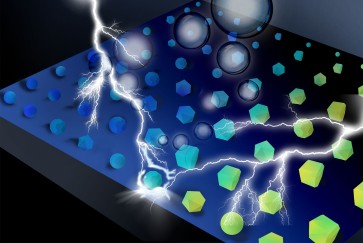Hydrogen is a promising fuel that could help drive the global transition to renewable energy. However, producing it is currently extremely carbon intensive and expensive.
Water electrolysis — the process of breaking apart water molecules using electricity — offers an ideal process for producing “green” hydrogen, but the catalysts for the process have not been well understood.
A new study from Northwestern researchers on the most promising studied catalysts — iridium-based oxides — enabled the design of a novel catalyst that maintains higher activity, longer stability and more efficient iridium use, which could make green hydrogen production feasible. The paper, published in the journal Nature Catalysis, identifies for the first time experimental evidence for how the surface of iridium oxide changes during water electrolysis.
“Our developments will help bring us closer to a sustainable energy future where green hydrogen via water electrolysis is a reality and widespread deployment of these emerging technologies are more technologically and economically feasible,” said Linsey Seitz, a Northwestern electrochemist and the paper’s lead author.
Seitz is an assistant professor of chemical and biological engineering at Northwestern’s McCormick School of Engineering and an expert in renewable energy.
Behind the findings
Iridium is a rare byproduct of platinum mining and the only catalyst that is currently viable for green hydrogen production due to the harsh operating conditions of the reaction. A technology called proton exchange membrane (PEM) water electrolysis is promising because it can run entirely on renewable electricity, but the reaction occurs in an acidic environment, which limits types of catalysts that can be used.
The reaction conditions also significantly change the structure of catalyst materials at their surface. These reorganized catalyst surface structures have been elusive to identify because they change rapidly in the process of water electrolysis and can be damaged through methods of imaging.
A novel technique
Prior research has computationally predicted possible connection types that may be present on the surfaces of iridium oxide but has never been able to provide direct experimental evidence. In the current study, three connection types previously described just as “amorphous” (having no detectable structure) following a catalytic reaction were found to have distinct, paracrystalline structures, and were found to be most responsible for a catalyst’s stability and activity.
The Seitz team’s workflow significantly reduced damage from imaging techniques to enable more accurate analysis of structures in complex materials. First, the researchers used electron-based microscopy and scattering to identify the catalyst surface structure, both before and after the water electrolysis process. They then confirmed results with high-resolution x-ray spectroscopy and scattering.
Creating more high-performance catalysts
Using their new understanding of the iridium, the team was able to design a catalyst using only paracrystalline structures that was three to four times more efficient than other iridium-based catalysts during its first measurement of activity.
Seitz is also looking forward to applying the new analysis techniques to other complex catalyst materials to identify their active structures.
“These fundamental insights will drive the design of high-performance catalysts that can optimally use precious metals and critical minerals content,” Seitz said.


